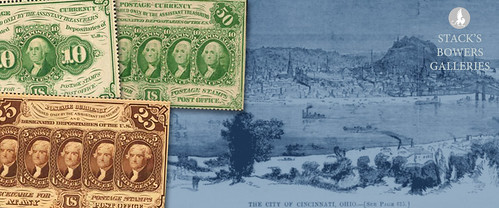
PREV ARTICLE
NEXT ARTICLE
FULL ISSUE
PREV FULL ISSUE
THE 1862 POSTAGE CURRENCY RIOTAs readers know, my numismatic specialty for many years was the U.S. Civil War and the explosion of new forms of money both North and South. The Small Change Panic of 1862 kicked off the process, and one Union attempt to solve the situation led to another problem. Here's a Stack's Bowers article by Chris Bulfinch on the small change riot in Cincinnati. -Editor In an age of cashless transactions, it's hard to imagine rioting over a shortage of small change. The economy of mid-19th century America, however, ran on physical currency and in November 1862 people in Cincinnati took to the streets, practically laying siege to the Customs House in response to an acute shortage of small change and a lethargic government response. The disappearance of small change at the outset of the Civil War – and the responses at both the legislative and local level – have been explored in detail by many numismatic historians. The monetization of postage stamps, authorized at the federal level in July 1862, introduced Postage Currency, subsidiary denomination paper bills redeemable for postage stamps or, in sums five dollars and greater, for United States notes; the notes could also be used to pay customs dues up to five dollars. Postage Currency would evolve into the longer-lived Fractional Currency in subsequent issues stretching into the 1870s. Distribution of this currency was often too slow for the rampant demand, as evidenced by the events that unfolded in Cincinnati in 1862. Enoch Carson had the misfortune of working as a customs collector in Cincinnati as the change shortage worsened in 1862. He traveled to Washington D.C. in October of that year to communicate the acuteness of the shortage and try to obtain more Postage Currency. He was promised a $25,000 shipment which, though woefully inadequate to meet the city's needs, would provide some relief. Notices posted in newspapers announced forthcoming distributions of Postage Currency and in the fall of 1862, the Cincinnati Enquirer advertised the $25,000 disbursement set for November 4. Citizens could buy up to $5, meaning that a tiny fraction of Cincinnati's 160,000 residents could count on purchasing the full allotment and stories of industrious (if less than scrupulous) people obtaining more than their share circulated. Unfortunately for Carson, on November 4, thousands of citizens queued up to receive their $5 ration and their mood soured after about $15,000 had been disbursed. The scene was chaotic, as described by the Enquirer:
The Army had to be called in to quell the disturbance at bayonet-point. The Enquirer estimated that fewer than 10% of the population obtained the notes. Carson suggested the City Council take over distribution of the notes, with each member distributing the cash in their respective wards. A version of this plan, which saw the notes distributed initially to government offices which controlled subsequent distribution, was eventually adopted.
Fred L. Reed's article The Cincinnati riot was not the first currency-inspired civil disturbance in U.S. history. Future blogs will focus on the Paper Money Riot that took place in Exeter, New Hampshire in 1786 and the 1740 Philadelphia Halfpence Riot. We'll look forward to further reports from the numismatic riot desk! -Editor
To read the complete article, see:
Wayne Homren, Editor The Numismatic Bibliomania Society is a non-profit organization promoting numismatic literature. See our web site at coinbooks.org. To submit items for publication in The E-Sylum, write to the Editor at this address: whomren@gmail.com To subscribe go to: https://my.binhost.com/lists/listinfo/esylum All Rights Reserved. NBS Home Page Contact the NBS webmaster 
|

